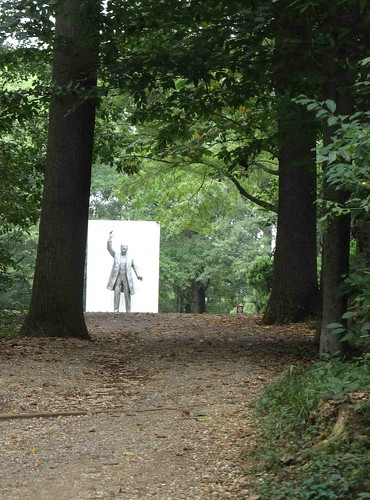
‘Teddy waves from on high’
courtesy of ‘snapzdc’
Theodore Roosevelt Island may not have sandy beaches and palm trees, but this little island definitely has secrets.
First, you have to know it’s there. From the frenzied lane-changing above on the Roosevelt bridge, you’d never know that a nature preserve nearly 90 acres large lies below.
Scores of people zip past it daily in their cars on the George Washington Parkway, too, or on bike or foot on the Mount Vernon trail–only a single footbridge lets people across from near Rosslyn.
And when you do find and wander onto the island, all you see at first is trees. It’s a bit of a surprise when you come upon the hidden plaza, with a moat, fountains, and a 17’ statue of Teddy Roosevelt towering overhead.
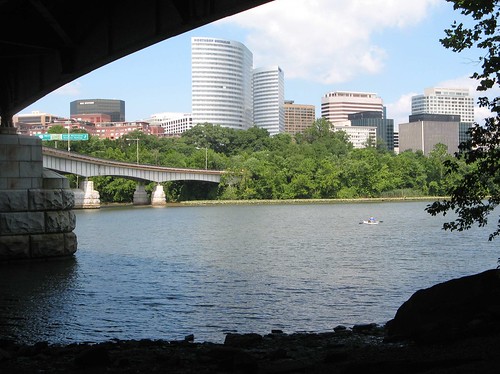
‘Great view of Rosslyn’
courtesy of ‘snapzdc’
You also can sneak peeks of the Rosslyn skyline and Georgetown, and of kayakers out on the water.
Another surprise is that wildlife lives on the island and shows itself to the visitors who walk and run there (you can go on foot only). Two and one-half miles of trail criss-cross a small hill and a swamp, where egrets and blue herons stalk fish and shiny blue lizards skitter along the boardwalk.
I’ve had a wild turkey stand calmly next to the trail and watch me pass by, and I’ve seen does, a buck, and spotted spindly fawns. One day not long ago, a fawn followed me a few steps of my run until, a bit unnerved, I stopped and turned around and explained that I was not Mum. He got the picture, and stood still. Then I noticed bubba or sis browsing in the bushes.
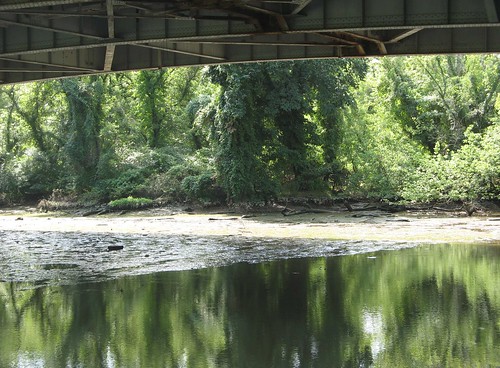
‘Under the Roosevelt bridge’
courtesy of ‘snapzdc’
Smack in the middle of the Potomac, the island is a good place to find fish, and fishing charts are stocked at the kiosk near the island’s entrance. But the people who fish here today are continuing the history of the island and carrying on the practice begun by Native Americans, who called the island “Analostan.”
You might think the island has always been a green, lush, forgotten spot full of nature. You might not expect that it once belonged to King Charles I, who granted it to Lord Baltimore, who gave it the lofty name of “My Lord’s Island.” Or that a later owner, a sea captain, dubbed it “Barbadoes” after the island where he grew up.
Today, most people wear athletic shoes to go there. But if you’d been around from 1792 to 1830, you would have gone there all decked out in your finery. At the time, John Mason, whose father George wrote the Virginia Declaration of Rights, had a brick Federal-style summer house on top of the hill in the middle of the island. Then the island was “a center of Washington and Georgetown society,” and the Masons ran a ferry between it and Georgetown.
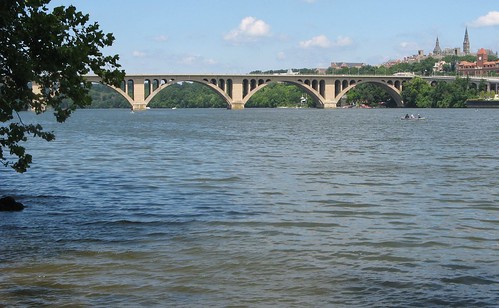
‘View from Roosevelt Island’
courtesy of ‘snapzdc’
One of the placards along the trail shows an 1818 map that “portrays the island as one continuous garden rich in native and cultivated plants, flowers, and fruits and divided by an avenue planted with trees.”
The Masons owned the island for over a century, but in 1784, an ice flood silted up the river. To deepen the Georgetown Harbor and keep the port open, a causeway was built between the island and the Virginia shore in 1805. While people could cross the causeway to reach the ferry the Masons owned, ultimately this was not the best arrangement for them. Stagnant water teemed behind the causeway, and they had to leave in 1832.
During the Civil War, black and white Union Army troops were stationed there.
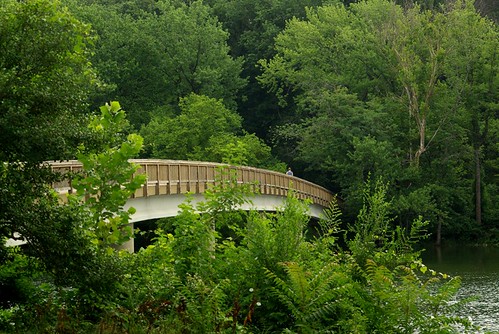
‘Alone on a bridge’
courtesy of ‘philliefan99’
The island also has been a picnic resort, owned by the Columbia Athletic Association and the Analostan Boat Club. Near the end of the 19th century, most of the island was open field, and the Columbia Athletic Association owned it. Apparently the Washington Gas Light Company let the plants grow wild.
The house caught fire twice around the turn of the 20th century, and finally was pulled down in preparation for the park. Greater Greater Washington has some great pictures of the house, which is now reduced to a few well-camoflagued bricks, and more history on it.
The Theodore Roosevelt Memorial Association bought the island in 1931 to turn it into a monument to our 26th president, who had a strong conservation ethic. Roosevelt provided federal protection for almost 230 million acres, a size equal to all of the East coast states from Maine to Florida. From 1901 to 1909, he designated 150 National Forests, the first 51 Federal Bird Reservations, the first 18 National Monuments, five National Parks and the first four National Game Preserves.
(Roosevelt is also why we have “teddy bears,” after he refused to shoot an old bear and cartoonists got hold of the story.)
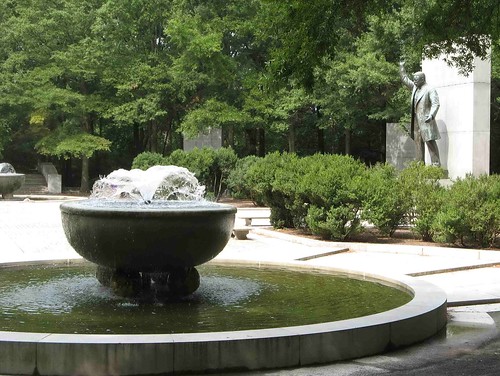
‘The plaza’
courtesy of ‘snapzdc’
The memorial, including the statue designed by Paul Manship, was dedicated on Oct. 27, 1967. It sits near the center of the island, surrounded by trees. If you like, you can reach the wide, flat stone plaza by way of one of the steep rounded bridges that remind me of the Cross Over the Bridge game I loved to play as a child.
It’s a nice, quiet place to sit and relax, and to wander around.
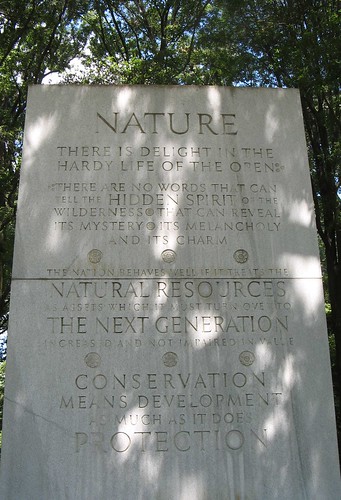
‘Roosevelt’s thoughts on nature’
courtesy of ‘snapzdc’
While you’re there, you can gaze up at the giant Roosevelt–you probably will be shorter than even the pedestal he stands on–or take on the tall stone tablets inscribed with his quotes. I like the one about nature, which reads in part “There are no words that can tell the hidden spirit of the wilderness, that can reveal its mystery, its melancholy and its charm.”
See, Roosevelt dug the hidden stuff, too. Perhaps he would have been pleased that this out-of-the-way island, full of trees and wildlife, was dedicated to him.
Pingback: Extra Swampy on Roosevelt Island » We Love DC